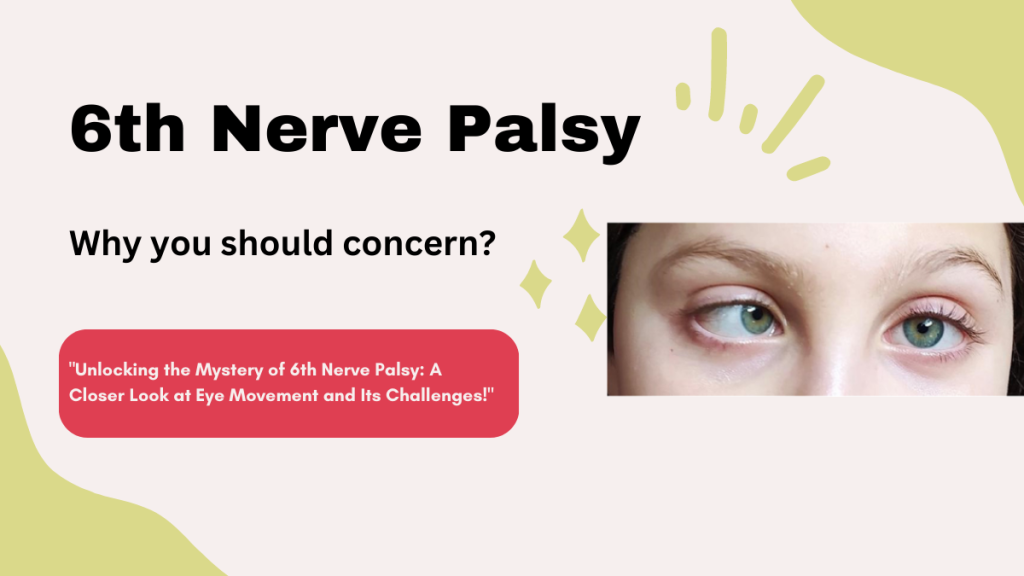What is sixth nerve palsy?
Sixth Nerve palsy is a medical condition that causes restricted eye movements due to improper functioning of the sixth cranial nerve (Abducens). It is one of the commonest ocular palsy.
Any injury or occlusion to this nerve pathway produces these symptoms. It takes a few weeks to recover spontaneously with proper medical treatment. However, serious pathological diseases associated with it must be diagnosed earlier for a better remedy.
Function of sixth Cranial nerve
Lateral rectus muscle of the eye supplied by the sixth cranial nerve. Thus helps your eyes lateral movement. When we look away from the nose this action of eye movement responds to this nerve.
Causes of sixth cranial nerve palsy
Adult
- Idiopathic (Not known cause)
- Diabetes mellitus
- Arteriosclerosis
- Hypertension
- Microvascular retinopathy
- Hypercholesterolemia
- Middle ear infection
- Temporal arteritis
- Anemia
- Head Trauma
- Stroke
- Leukemia
- Any tumor compressing the nerve pathway
- Nasopharyngeal carcinoma
- Mastoiditis
- Aneurysms
- Multiple sclerosis
- Infection – Lyme disease etc.
Children
- Brain tumors
- Birth trauma to head
- Hydrocephalus
- Cerebral palsy
- Raised intracranial pressure
- Meningitis
What are the Symptoms of Sixth Nerve Palsy
- Decrease vision
- Double vision
- Unable to move eyes to his left.
- Pain during eye movement
- Headache
- Eye pain
What are the Investigations for Diagnosis of Sixth Nerve Palsy
- CT-Scan (Computed tomography) of Brain
- MRI (Magnetic Resonance imaging)
- CTA (Computed tomography angiography)
- Blood Glucose analysis for diabetic patient
- X-ray skull
- CBC (Complete Blood count)
- Thyroid function T3,T4, TSH
- VDRL for syphilis
Management of sixth nerve palsy
Medical management
- Eye patch for relieving double vision
- Eye medications – artificial tear, antibiotic eye drop
- Botulinum injection
- Systemic drug for pain and nerve healing
- Other symptomatic treatments related to it.
- Vitamins B6, B12
Surgical management
- Strabismus eye surgery for complicated cases.
- Intracranial surgery for tumor or trauma
Refractive correction
- Prism refraction
What are the complications of Sixth Nerve Palsy
- Persistent double vision: In some cases, the double vision associated with sixth nerve palsy may not go away completely. This can be a significant problem, as it can make it difficult to drive, read, and participate in other activities.
- Vision loss: In rare cases, sixth nerve palsy can lead to vision loss. This is usually due to damage to the optic nerve or other structures in the eye.
- Other neurological problems: Sixth nerve palsy can sometimes be a sign of a more serious underlying neurological condition, such as a stroke, brain tumor, or multiple sclerosis.
Frequently Asked Questions
1. How long does it take for sixth nerve palsy to heal?
The time it takes for sixth nerve palsy to heal varies depending on the underlying cause. In most cases, the palsy will resolve on its own within 6-8 weeks. However, in some cases, it may take several months or even years for the palsy to heal completely.
2. Can sixth nerve palsy cause blindness?
No, it causes double vision that can decrease visual acuity.
3. Can sixth nerve palsy be caused by stress?
Stress is not a common cause of sixth nerve palsy.
4. How Diabetes causes sixth Nerve Palsy?
Diabetes can be a cause of sixth nerve palsy. Diabetes can damage the small blood vessels that supply the nerves, which can lead to nerve palsy.
References
- Ibekwe E, Horsley NB, Jiang L, et al. Abducens Nerve Palsy as Initial Presentation of Multiple Myeloma and Intracranial Plasmacytoma. J Clin Med. 2018;7(9):253. Published 2018 Sep 3. doi:10.3390/jcm7090253
- Kim JH, Hwang JM. Imaging of Cranial Nerves III, IV, VI in Congenital Cranial Dysinnervation Disorders. Korean J Ophthalmol. 2017;31(3):183-193. doi:10.3341/kjo.2017.0024

